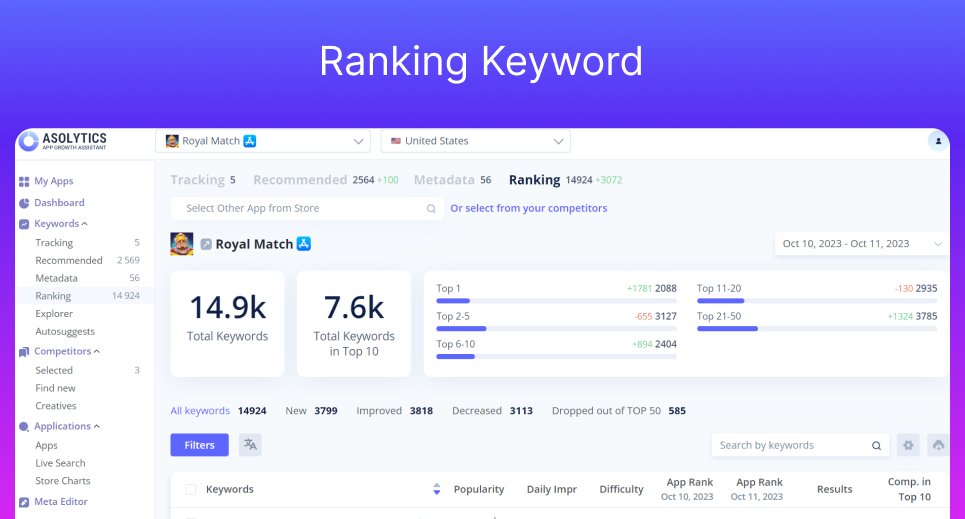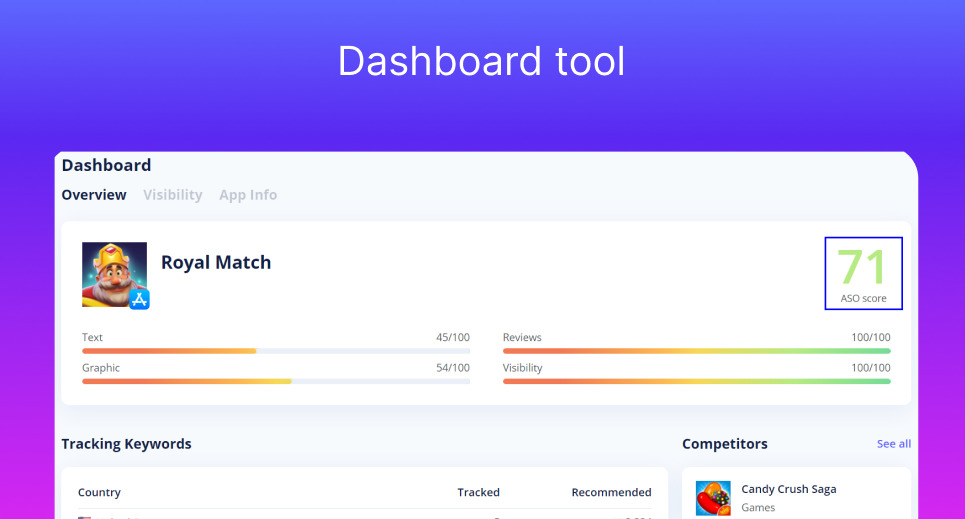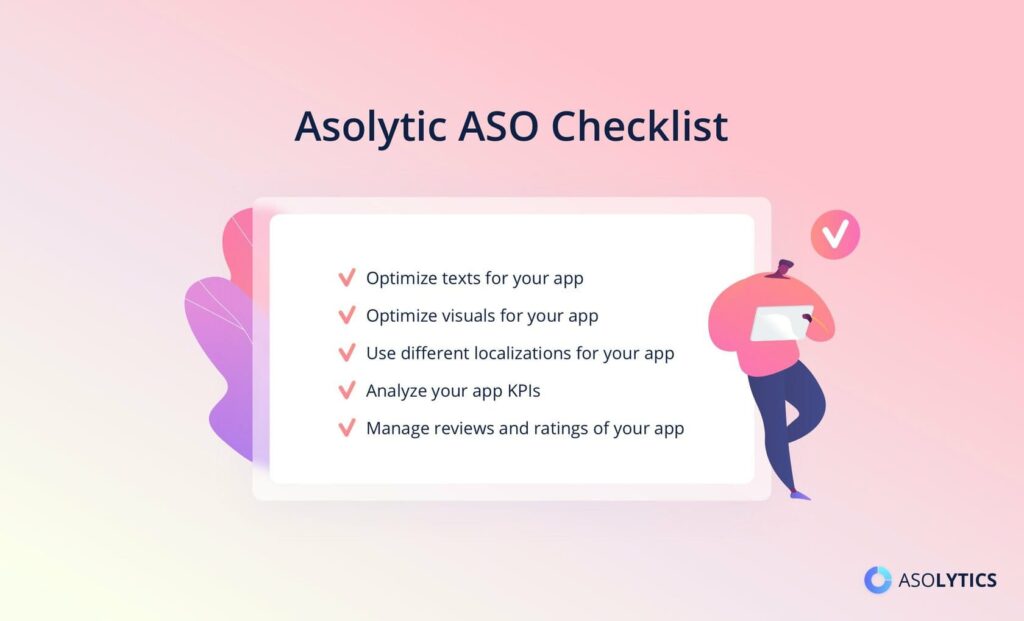ASO is not only about app optimization, it’s also about business strategies and app KPIs. It’s easy to get confused by all of the things you need to do to manage an app. We offer the simplest ASO scheme based on in-app marketing tips to help you organize your thoughts. Look at these three app management steps:
Table of Contents
- You need an ASO strategy to follow. Before you set off on your exciting journey of exploration around the world of app store optimization (ASO), it is wise to equip yourself with a well-planned strategy, which will be your roadmap to increasing app visibility and driving more downloads. It will show you clear direction, help you set priorities right, and keep you accountable and motivated. It will also clearly outline the key focus points and desired milestones, as well as consider factors like target audience, competition analysis, keyword research, and branding. In simple words, a good ASO strategy will tell you where you need to go, how to get there, and what to do along the way.
- You need to optimize the app for an app store (this is what our checklist is for).
At the core of any ASO effort, there is always optimization of your product for app stores. This step involves a few critical tasks aimed at enhancing your app’s visibility within the platforms it is promoted on. These tasks range from simple keyword optimization in the title and description to creating eye-catching app icons and screenshots. It is done to help your app rank higher in search results, thus appearing and appealing to more potential users. Skipping or not prioritizing ASO is a path to failure. More about this essential step will be covered later in this article. - You need to understand your app KPIs and be ready to revise your strategy (ASO audit). Key Performance Indicators (KPIs) play a vital role in determining the success or underperformance of your app within app stores. Optimizing your app once and then sitting idly by waiting for a miracle to happen is naive – you need to continually monitor and analyze your app’s performance, tracking various metrics such as app downloads, user retention, engagement, conversion rates, and revenue generation and tweaking as needed to keep your app on the right path. Compiling a comprehensive aso checklist and performing a thorough ASO audit is crucial, as, if done correctly, it will help you identify areas for improvement and fine-tune your ASO strategy accordingly.
In this article, we will focus on the second step, the one about optimizing your app for an app store. Thus, we’ll share a brief and comprehensive checklist for app store optimization from the mobile app marketing best practices.
After getting acquainted with the checklist, you can move further in our Asolytics ASO Academy. We have prepared detailed guides on how to provide app optimization for every checklist step.
It’s Not Just Optimization: ASO Strategy and App KPIs
App optimization is just one of the things you’ll have to deal with. Before we share the checklist with you, we want to be sure that you understand the importance of ASO strategy and app KPIs analysis.
Implementing an ASO strategy means that you gather and analyze data about the category your app fits, data about your competitors, establish deadlines, etc. Strategy is not only about text and visuals optimization, but also a business plan for your app. You choose how to manage app promotion according to the result you want to achieve and your possibilities. Building an ASO strategy is the first step before launching an app. It combines a research stage plus planning, which is common for any project and pretty much any business.
10 Compelling Reasons Why Your App Needs ASO And a Good Strategy to Go With It
If you are still not sure about the importance of ASO or do not think your app or game needs it, just take a look at these top 10 benefits of a well-executed ASO strategy:
- More visibility perfectly optimized and meticulously conducted ASO can boost your app’s visibility sky-high in app stores, making it much more likely to be discovered and downloaded by potential users.
- Improved search rankings by doing as little as optimizing your keywords in the app’s title and description, you can set your product for huge app store success, helping it rank higher in search results and increasing its chances of being noticed.
- Better user acquisition ASO helps attract more organic and high-quality users, i.e., those who are genuinely interested in what you are offering and have every intention to download and possibly even pay for it. This often reduces the need for expensive marketing campaigns.
- Enhanced user retention when users can find real value in your product and have their expectations met without any deception, they are more likely to stay and actively use your app, which, in turn, boosts user retention. ASO helps this by increasing your app’s visibility and setting it up to connect with the right target audience.
- Competitive edge part of effective ASO is following and analyzing your competitors’ strategies and tactics. Understanding their successes and learning from their mistakes will give you the necessary knowledge and insights to position your product more competitively.
- Higher conversion rates a well-optimized app page containing compelling visuals and skillfully crafted descriptions leads to higher download and conversion rates. For example, using screenshots and videos that demonstrate the app’s features can convince users to install your product.
- Greater revenue for the developer a successful ASO strategy can boost downloads, resulting in higher revenue for developers. For mobile game makers, optimizing their in-app purchase ASO is an especially valuable tactic that can lead to more in-game sales and greater user satisfaction.
- More cost-effective marketing while marketing methods such as paid advertising, email campaigns, press releases, professional reviews, and referral programs are effective for attracting users to your product, they can also be very expensive. ASO can reduce your ad spend by improving your app’s visibility and inviting organic traffic.
- Truthful and valuable user feedback ASO can help app developers collect valuable insights from user reviews and ratings, which allows them to make informed and well-reasoned improvements to their products.
- Quick adaptation to trends monitoring the changes in the trends and algorithms of the app store where your product is offered will help your app stay relevant and continue to attract new users. For example, adjusting your app to be compatible with OS updates will allow it to remain accessible to users.
With a well-planned ASO strategy, these benefits work together to boost your app’s popularity, user satisfaction, and overall success. They can be effectively measured through KPIs, like higher ratings, increased downloads and conversions, and more positive user reviews.
And what are the indicators of your ASO strategy working?
Your app appears higher in the app store’s search rankings.
- The app is being installed due to its popularity.
- The bounce and churn rates for your app decrease.
- You get more good reviews and better ratings.
- You notice an increase in how long user sessions last.
- You gain as much income as you had planned.
Still, app success can be measured by its KPIs in the app store. To understand if the app is visible enough, you need to estimate its popularity indicators. We described them extensively in the Academy’s guide. However, we will gladly give you a short recap below. Remember that monitoring app KPIs helps you to correct your strategy.
To make your app successful, always mind the following seven KPIs that affect how it performs in the app store and how many users see it. By closely tracking these metrics, you will be poised to make informed decisions and improve your product’s performance:
- Keyword rankings: indicates where your app appears in search results for the keywords you are targeting. The more keywords your product ranks for, the greater its visibility.

Get data out how an app is ranked with particular keywords using the Ranking keyword tool
- Category rankings: provides insights into your app’s position in specific category rankings.
- Similar or related apps: lets you compare the effectiveness of your ASO efforts to your closest competitors.

Use the Competitors tool in Asolytics to find all the similar apps in your niche
- Top chart positions: allows you to see how your keyword metrics, conversion rates, and user reviews change when your product makes it into the top charts.
- “Featured”: getting featured on the app store’s home page drives much traffic to the product page, so it is one of the most important KPIs to measure.
- Visibility score: shows how your app’s visibility compares to similar apps by considering the number and volume of keywords it ranks for.


Track your app’s visibility score using the Dashboard
- Keyword impact: reveals the impact of keyword updates on your app’s organic downloads. It provides information that helps you target the most valuable keywords, thus increasing installations of your product.
To learn more about the significance of each of these KPIs and understand how they benefit developers, please visit our dedicated Asolytics Academy page, where we provide comprehensive insights and expert guidance on app store visibility improvement and ASO in general.
If you are managing an app, your number one goal is to make it more visible. Your business area is not a physical market, it’s an online store: App Store vs. Google Play. These two platforms have differences, rules, and limitations. That’s why following their rules is the best way to increase your app visibility. And the more precise you are, the bigger audience you get. At our Academy, we prepared guides both for App Store and Google Play. You can immediately start by learning the difference between Google Play and App Store app ranking.
Nobody knows all the algorithm features of App Store and Google Store. Still, app developers have enough official information or insights from their experience to manage app promotion in the app stores. This is what ASO specialists do.
Do you need ASO specialists to manage your app in 2022?
ASO has been developing fast for the last few years. Now you can delegate your app management to services or make it by yourself with the ASO tools that some platforms provide. Both options are good.
You should know that the app can be managed by a small team or only by yourself using tools for that. There is no critical need to delegate this — Asolytics Team
Just remember that every step should be considered:
- ASO strategy
- App optimization
- App KPIs audit
Now you are ready to learn what things make up an app optimization. Follow these checklist points to see what work you should do to boost your app.

App Optimization Checklist:
The world of app stores is super crowded, the competition is cutthroat, and your product is just one of the 3.5M apps in Google Play and nearly 2M apps in the Apple App Store. So, how do you get your app noticed and downloaded? That is the question aspiring app developers keep asking themselves when they launch their products on one of these two digital marketplaces. Luckily, the answer is right there, and it is called App Store Optimization (ASO).
A thoroughly planned and well-executed ASO campaign is something that can give your app a competitive edge within busy Google Play and Apple App Store markets and set it up for incredible success. When armed with the right strategies, you can make sure your app gets the attention it deserves.
As mentioned earlier, the first step in your ASO journey should be creating a comprehensive and actionable ASO checklist that will show you the direction to move in and the priorities to focus on.
Never done that before and are clueless as to where to start? That is OK – we have got you covered! Follow these simple yet powerful ASO checklist creation tips to boost your app’s visibility, engage more users, and achieve fantastic success:
- Optimize texts for your app
1.1. Look for the keywords for your app.
1.2. Use these keywords for the title and subtitle, short and long descriptions.
Why? It can increase your app visibility due to the metadata indexation which Google Play and App Store use. This is similar to SEO actions, though we deal with the app stores but not with the browser search engine.
When? It is best to implement this step during the initial launch and then repeat it regularly whenever you update your app’s information.
How? Conduct in-depth keyword research and strategically place them in your app’s title, subtitle, and descriptions. Asolytics keyword research and analysis tools, as well as the platform’s own data-driven insights, will help you pinpoint the most relevant and best-converting keywords with which you can target the right audience.
What not to do? Avoid the temptation to stuff as many keywords as you can think of or use irrelevant terms that sound nice but do not fully reflect your app’s functionalities. Misleading your potential users with keywords that do not apply to your product is a sure way to lose them forever.
Note: Google Play doesn’t have a subtitle block while App Store does. Moreover, App Store has a separate field for the keywords. Thus, here is the first thing to consider when making ASO: Google Play and App Store differ. Read these guides to learn how to ASO keyword research and use them for apps in Google Play or App Store.
- Optimize visuals for your app
2.1. Create app preview videos, appealing icons, and screenshots.
2.2. Test them to know if they work.
Why? First, app stores have requirements for the visual elements, so you better follow them. Second, effective visuals attract users and make them install the app.
When? Prioritize this during the app development phase and implement simultaneously with keyword optimization. Make sure you periodically refresh your visual content to keep your users engaged.
How? Create engaging app preview videos, appealing icons, and screenshots that comply with the specific guidelines of each app store. Never include misleading or false information about your product in your visual creatives to avoid harming your app’s credibility and driving away users.
What not to do? Also, avoid using low-resolution images or visuals that misrepresent your app’s features or functionalities. The crisp quality of your creatives is essential to leave a positive impression on potential users and persuade them to give your product a try.
Note: This is where Google Play and App Store have a little bit different requirements too. To learn how to work with visuals, read guides for the Google Store and App Store. Also, we recommend you implement a simple A/B test icon for the app’s visuals.
- Use different localizations for your app
Do you know that you can localize your app in more than one country? In turn, it means that you can use more specific keywords in different languages. Different localizations can broaden your audience, and, thus, more people all over the world will see your app.
To find out how to localize an app in the app store, read the guide for Google Play or App Store.
Why? Implementing different localizations helps expand your app’s reach. By using region-specific keywords in multiple languages, you will be able to attract a diverse global audience.
When? Make localization a vital part of your expansion strategy. It is wise to consider localizing your app for different regions when entering new markets.
How? Explore ASO localization options available within the app store and strictly follow the specific guidelines provided for Google Play and the Apple App Store. A thorough keyword research and analysis is once again at the heart of it all.
What not to do? The worst mistakes a developer can make when localizing their app store content for other markets include forgetting that the same text can take up a different amount of space in different languages, not maintaining consistency in terms, neglecting the importance of cultural imagery, not converting time, date, and currency formats.
Note: Pay attention to the specific guidelines and language nuances provided by both Google Play and the App Store to create a well-adapted and culturally sensitive localization experience for your users.
- Analyze your app KPIs
We have already mentioned that analyzing app KPIs is one of the ASO tasks besides app optimization and ASO strategy. There are several indexes that can tell how well is your app adapted for the app store, including texts, visuals, conversion rate, etc.
If you want to learn what app KPIs matter and what they say about your app store optimization, check out How to Measure ASO: App KPI In-Depth Guide.
Why? Monitoring your app’s key performance indicators (KPIs) provides valuable insights into how your product is doing in the app store and highlights the areas that need improvement.
When? KPI tracking should be performed at every stage of the app’s lifecycle within the app store. From the initial launch to subsequent updates – every tiny change made to your app needs to be tracked. The more mature your product gets and the more weight it gains within the chosen marketplace, the more metrics are to be followed and assessed.
How? Use analytics tools to measure KPIs accurately and employ data-driven strategies for effective optimization.
What not to do? Do not concentrate solely on one performance indicator, even if you think it is the most important of them all. There are dozens of metrics that can be very effective in helping you understand your app’s performance and how it impacts the overall user experience.
Note: Leverage only data analytics tools that align with Google Play and App Store guidelines for accurate assessment.
- Manage reviews and ratings of your app
Read this guide to start managing app store ratings and reviews properly. To see what apps make top in your category, go to app ranking stats.
Why? Taking due care of your app’s app store ratings and reviews helps build a good image for your product and your brand and keeps users more engaged.
When? Always. Make it your constant, never-changing priority to deal with user feedback quickly and efficiently to keep your app’s reputation positive.
How? Create a well-thought-out plan that details your approach to handling reviews, addressing user concerns, and encouraging positive feedback. Allocate sufficient resources toward the effective realization of that plan and remain flexible and adaptable to evolving user needs and preferences.
What not to do? It is simple: do not ignore user feedback, do not respond in a defensive manner to negative comments, and never criticize your users for not liking your product. Instead, consider it a valuable opportunity to tap into meaningful insights and improve your app’s overall user experience.
Note: Analyze Google Play and Apple App Store’s top-ranking apps in your category to see how they manage user feedback and reviews.
FAQ
Let us now quickly sum up what we have already learned about App Store Optimization (ASO) and the importance of creating an effective and comprehensive aso audit checklist before launching your app within one of the major mobile app marketplaces like Google Play or Apple App Store.
Why do you need an aso checklist?
An ASO checklist is crucially important to ensure your mobile app or game is perfectly optimized for digital distribution platforms like Apple App Store and Google Play Store. It helps improve your app’s visibility, attract more users, and increase downloads.
ACO checklist where is the best place to start?
The best place to start with your ASO checklist is by understanding your target audience, identifying relevant keywords, and optimizing your app’s metadata accordingly. Another important, not-to-miss step would be analyzing the strengths and weaknesses of your competitors’ ASO strategies.Remember, the world of mobile applications is a fiercely competitive one, and a meticulously crafted ASO checklist serves as your guide to successful app optimization that will lead to enhanced visibility and improved user engagement. It is something that will help you keep your focus and stay on the right track.If you have other questions about ASO in general and creating ASO checklists in particular, do not hesitate to explore our website further or reach out to us directly for individual consultation.
What to Do If You Cannot Create an ASO Checklist Yourself?
If you very well understand the importance of having an effective ASO checklist but find its creation challenging or simply cannot spare the time to get it done, consider leveraging professional services like Asolytics. Our extensive knowledge in the field of App Store Optimization, backed by years of hands-on expertise and further empowered by our robust toolkit of robust ASO analytics instruments, will help you craft tailored solutions that will meet your product’s unique needs and ensure its optimal visibility and user engagement.
What Asolytics can give you:
A vast repository of keywords to track;
Detailed analysis of your keyword impact across various countries;
Effective strategies for optimizing your app metadata across various regions;
A thorough analysis of your app’s performance across multiple countries;
Detailed store charts featuring all the key metrics;
Access to a robust Meta Editor tool;
Expert tips, checklists, and an extensive ASO knowledge base available at your fingertips;
5 Steps to Get What You Want From Your App
Launching a mobile app is a startup that needs your regular attention. It would be a pity if your app idea is great and might be selling, but you are not prepared technically to manage this app. That’s why we created an Academy with up-to-dare mobile app optimization techniques to help you learn how to do it. And if you are working out an app idea, then the article about how to sell an app idea may be useful for you.




